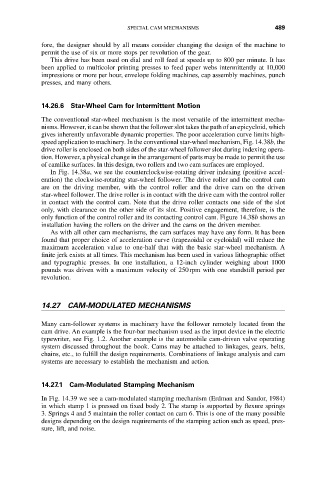Page 501 - Cam Design Handbook
P. 501
THB14 9/19/03 7:58 PM Page 489
SPECIAL CAM MECHANISMS 489
fore, the designer should by all means consider changing the design of the machine to
permit the use of six or more stops per revolution of the gear.
This drive has been used on dial and roll feed at speeds up to 800 per minute. It has
been applied to multicolor printing presses to feed paper webs intermittently at 10,000
impressions or more per hour, envelope folding machines, cap assembly machines, punch
presses, and many others.
14.26.6 Star-Wheel Cam for Intermittent Motion
The conventional star-wheel mechanism is the most versatile of the intermittent mecha-
nisms. However, it can be shown that the follower slot takes the path of an epicycloid, which
gives inherently unfavorable dynamic properties. The poor acceleration curve limits high-
speed application to machinery. In the conventional star-wheel mechanism, Fig. 14.38b, the
drive roller is enclosed on both sides of the star-wheel follower slot during indexing opera-
tion. However, a physical change in the arrangement of parts may be made to permit the use
of camlike surfaces. In this design, two rollers and two cam surfaces are employed.
In Fig. 14.38a, we see the counterclockwise-rotating driver indexing (positive accel-
eration) the clockwise-rotating star-wheel follower. The drive roller and the control cam
are on the driving member, with the control roller and the drive cam on the driven
star-wheel follower. The drive roller is in contact with the drive cam with the control roller
in contact with the control cam. Note that the drive roller contacts one side of the slot
only, with clearance on the other side of its slot. Positive engagement, therefore, is the
only function of the control roller and its contacting control cam. Figure 14.38b shows an
installation having the rollers on the driver and the cams on the driven member.
As with all other cam mechanisms, the cam surfaces may have any form. It has been
found that proper choice of acceleration curve (trapezoidal or cycloidal) will reduce the
maximum acceleration value to one-half that with the basic star-wheel mechanism. A
finite jerk exists at all times. This mechanism has been used in various lithographic offset
and typographic presses. In one installation, a 12-inch cylinder weighing about 1000
pounds was driven with a maximum velocity of 250rpm with one standstill period per
revolution.
14.27 CAM-MODULATED MECHANISMS
Many cam-follower systems in machinery have the follower remotely located from the
cam drive. An example is the four-bar mechanism used as the input device in the electric
typewriter, see Fig. 1.2. Another example is the automobile cam-driven valve operating
system discussed throughout the book. Cams may be attached to linkages, gears, belts,
chains, etc., to fulfill the design requirements. Combinations of linkage analysis and cam
systems are necessary to establish the mechanism and action.
14.27.1 Cam-Modulated Stamping Mechanism
In Fig. 14.39 we see a cam-modulated stamping mechanism (Erdman and Sandor, 1984)
in which stamp 1 is pressed on fixed body 2. The stamp is supported by flexure springs
3. Springs 4 and 5 maintain the roller contact on cam 6. This is one of the many possible
designs depending on the design requirements of the stamping action such as speed, pres-
sure, lift, and noise.

